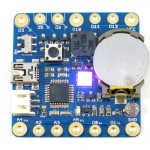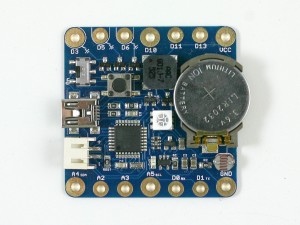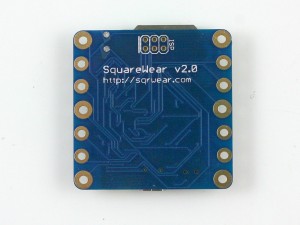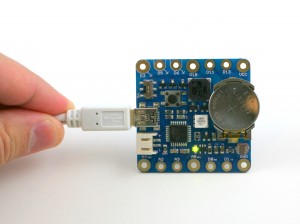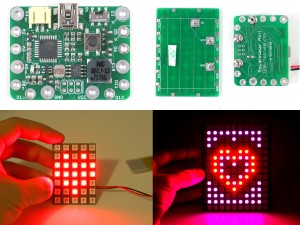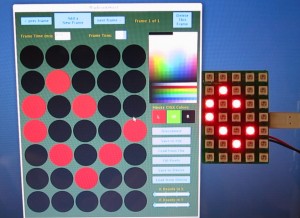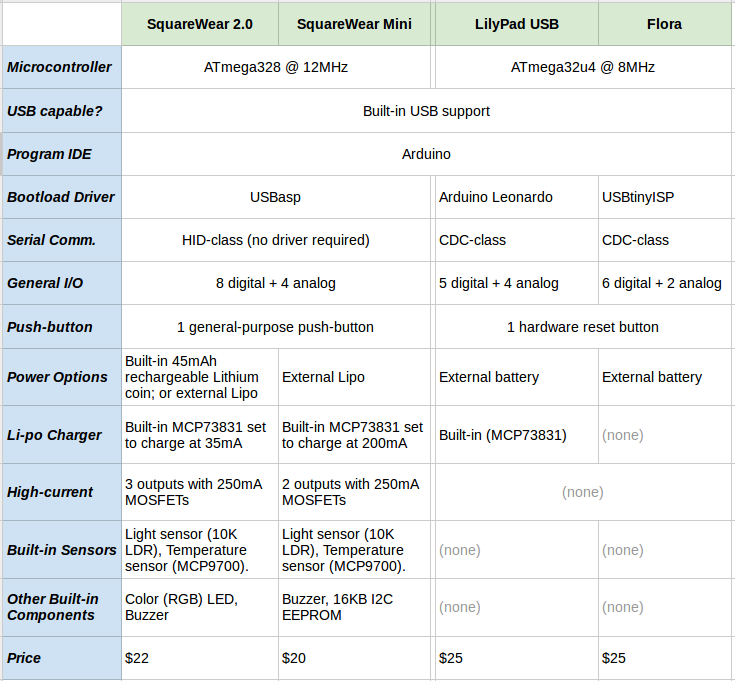SquareWear v2 and Mini
An Open-Source Arduino-based Wearable Microcontroller
Updates
- Sneak peak preview of SquareWear 2.3
- SquareWear Mini and color LED matrix are released and available for purchase at Rayshobby Shop.
- SquareWear user manual and software demos have been updated. Check the User Manual page.
- SquareWear v2 used at Mount Holyoke College’s iDesign Studio class.
Overview
• What is SquareWear v2?
SquareWear v2 is an open-source, Arduino-based wearable microcontroller board. It is small, low-cost, and provides an all-in-one solution for wearable electronics projects. At heart it’s an Arduino running at 3.3V and 12MHz. It has large pin holes to allow conductive thread to stitch through. You can also solder wires directly, or solder snaps for quick attachment and detachment from textile. The large pins are also great for touch sensing. SqureWear v2 is packed with useful components. It has an on-board mini-USB port, which is used for programming, for charging batteries, and for serial communication. No external programmer or USB serial converter is required. It has a color LED, a general-purpose push-button, a buzzer, a light sensor, a temperature sensor, and three MOSFETs to drive high-current load. In addition, it has a built-in rechargeable lithium coin battery, so you can power your projects right away without external power supply. Every time you plug in the mini-USB cable, it charges the coin battery automatically. If you want a higher-capacity battery, you can also plug in an external lithium battery through the on-board battery jack. The on-board lithium charger can charge either the coin battery or external battery. It’s perfect for building wearable electronic projects as well as general-purpose microcontroller projects. It’s also a great platform for learning Arduino programming.
Unlike the standard Arduino, SquareWear does not have a separate USB-to-serial chip. Instead, it simulates USB functionality all in software, using the V-USB library. It has a USBasp bootloader, and can perform serial communication through USB. It can also simulate a mouse, a keyboard, or other human interface devices (see V-USB example projects). While software-based USB is not that fast, it really helps reduce the cost and size of the board by having one chip to carry out all the tasks. That’s why we can offer SquareWear v2 at a very competitive price.
• What is SquareWear Mini?
SquareWear Mini is a variant of SquareWear v2 — it has the same set of components except it doesn’t have the built-in coin battery and color LED. It is 25% smaller than SquareWear v2, and it has added an extra 16KB EEPROM. Like SquareWear v2, the Mini is a general-purpose, wearable microcontroller board, but it’s also specially designed to plug into our new chainable color LED matrix. This enables a whole new set of applications that involve color display. We also provide a cross-platform software for interactively designing pixel patterns and even an animation!
• Technical Spec
- ATmega328 running at 3.3V, 12MHz, pre-flashed with USBasp bootloader.
- MCP1700 3.3V / 250mA LDO linear regulator.
- MCP73831 Lithium charging chip and charging indicator LED.
- MCP9700 temperature sensor; 10K LDR (light sensor).
- 8.5mm SMT buzzer; 6mm SMT tactile button.
- 2.0mm JST connector for external lithium battery.
- 2N7002 MOSFETs, SMT mini-USB port, and power switch.
- 5mm color (RGB) LED (not available on Mini).
- LIR2032 (20mm) rechargeable lithium coin battery (45mAh capacity) (not available on Mini).
- 24LC128 I2C EEPROM (available ONLY on Mini).
• How is SquareWear different from LilyPad Arduino USB and Adafruit’s Flora?
LilyPad Arduino USB and Adafruit’s Flora are two popular wearable electronics board based on the Arduino too. Here is a summary of the main differences:
Buy SqureWear v2 from Rayshobby Shop.
(SqureWear 1.1 homepage is archived here.)
